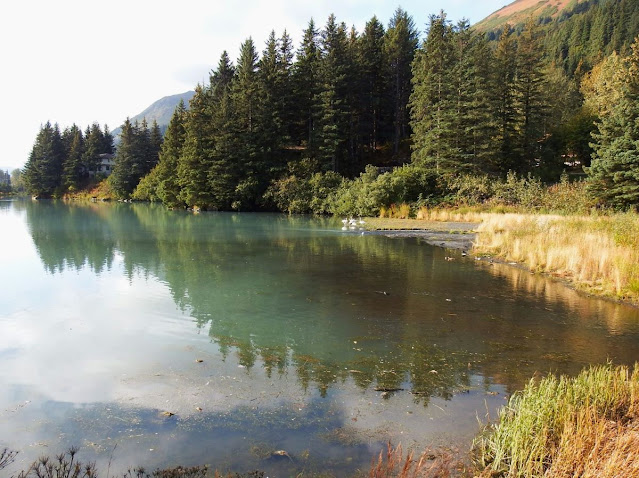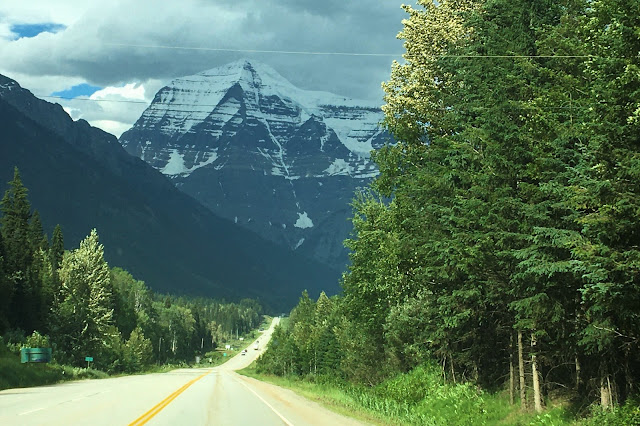NORTHBOUND EIGHT: SALMON
Fresh water, life
swims
salty, swirling
gyre
fresh water, death
swims
The Pacific Salmon is a critical part of what we know as
the Pacific Northwest. The fish are absolutely fascinating. They hatch in fresh
water lakes and upper streams and rivers, the fry make their way downstream to
the ocean where they live for years and then return once again to fresh water.
To facilitate that journey, their bodies undergo incredible changes. Once they
return to the very waters they were hatched from, the females lay eggs and the
males issue sperm. At that point, both adults die. But their story does not end
there.
Since the end of the ice age, the spawning and dying fish at coasts, lakesides, inlets, and streams has provided rich fats, vital nitrogen and oceanic nutrients to the other wildlife that consumes them. Eagles, ravens, bears, and wolves return into the forests with their catches and the byproducts feed the trees and forest floor. Salmon nitrogen is found in the tree rings of Sitka Spruce, Douglas Fir, Western Hemlock, and Western Red Cedar.
This poster illustrates the bodily changes that occur
when salmon return to fresh water after their ocean phase.
*Chum are at sea for four-seven years while Coho and Pink
return in less than two.
*Sockeye return after two years while Chinook may remain
at sea up to eight years.
*Steelhead are ocean trout, with salmon behavior,
returning in about three years.
Salmon names are confusing and alternate names are used
regionally. Chinook is sometimes called King Salmon, Coho is often referred to
as Silver, and a Pink is a Humpy. Sockeye is also called Red Salmon.
Preparing some fresh caught Sockeye, a truly red fish.
Each type of salmon has its spawning season and some streams boast all five varieties in sequence. Upriver runs sometimes overlap. Most modern schedules refer to the runs, aimed at the tourist fishing industry. As we learned, the dates are not exact and any number of factors can shift a schedule. The actual spawn occurs when the fish do arrive back at their destination – their birthplace.
Below, a female chum laying eggs, on her side, she taps them with her tail to settle them in the gravel bed. The male is following to fertilize them (see the cloud of sperm behind him). Williwaw, Kenai, AK
Lagoon in Seward
Coho spawning and then . . .
In the past . . . salmon runs were understood and fished sustainably by the indigenous peoples, with strict rules regarding how many could be taken to ensure a continuous supply over generations. If nets spanned rivers, it was done briefly and/or daylight only hours to allow the upstream passage. They knew if the fish were not allowed to spawn, the future was jeopardized for all.
The dark spots in the water below are salmon fins. Taiya River flats, AK
Chum salmon just beginning the upstream swim or run.
Coho at Williwaw
Prince William Sound
On our marine tour of Prince William Sound (see Chapter 6), we were
entertained by so many salmon jumping.
These were Pinks. Their internal clocks were telling them it was time to go upstream from Unakwik Inlet (arrow on map).
I was horrified to learn they are not allowed to go upstream. Instead, they are captured and squeezed of their eggs and sperm. From this process, new fish are grown in the hatchery to be released for the fishing frenzy that follows. None of the fish reenter the forest ecosystem.
It is sobering to learn that hatcheries control the waters along the Pacific coast from California to Alaska for economic interest in industrial fishing and sportfishing. It certainly makes me question the meaning of wild salmon that actually began life in a factory.
Port Alberni, BC
I had actually lived in Port Alberni in the late 70s, working as a deckhand on a salmon boat. It was a wide little fifty-footer with trolling lines (not nets).
Independent fishermen hadn't yet adopted the expensive new freezer boats. Fish were kept in deep ice in the hold and catches were frequently taken to Victoria to sell during the season. At the end of the season, the longer travel time around the island to Vancouver, brought a better price.
This trip, we were tourists sipping our coffee and chai. I pondered what is really considered progress.

















Comments
Post a Comment